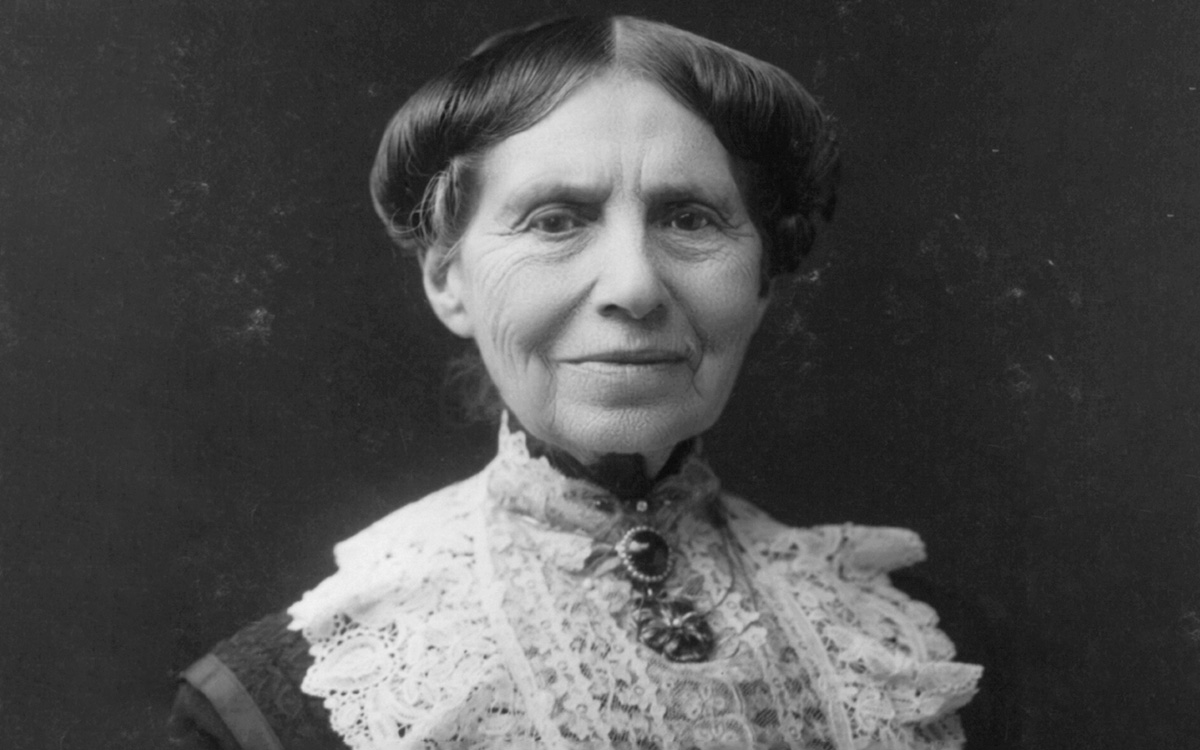Women of History: Clara Barton

Portrait of Clara Barton, circa 1904. Photo by J.E. Purdy.
Library of Congress, Prints & Photographs Division, LC-USZ62-75827.
(Updated April 14, 2025)
Clara Barton is known for her work as a humanitarian, teacher, and nurse. She was also a contemporary of Mary Baker Eddy. The two women shared the common goal of alleviating human suffering. Although they went about their pursuits in different ways, both worked tirelessly for their respective causes.
Barton was born Clarissa Harlowe Barton on Christmas Day 1821, in Oxford, Massachusetts. Perhaps the first example of her lifelong devotion to caring for others occurred when she nursed her brother David over a period of years, after he had been injured in an accident. Although doctors had given up hope for him, he fully recovered.
Barton became a teacher at the age of 15 and started her own school in Bordentown, New Jersey. Following this, she moved to Washington, DC, where she worked as a clerk in the United States Patent Office. There her anti-slavery views made her controversial. She lost the job in 1857, after James Buchanan became president.
At the beginning of the American Civil War in 1861, Barton was one of the first volunteers at the Washington Infirmary. She left the city hospitals to help soldiers in the field, organizing assistance in gathering first aid supplies, transporting water, and preparing food. Often she used her own money to pay for the supplies. Her presence in battlefield situations became commonplace, including service at Fredericksburg, Antietam, and Charleston. Barton’s ability to withstand harsh physical and emotional conditions on the front lines was remarkable, even though her own health suffered. She was nicknamed “The Angel of the Battlefield.”
Following the war, President Abraham Lincoln appointed Barton General Correspondent for the Friends of Paroled Prisoners. She oversaw the locating of information on over 21,000 missing soldiers, searching for their names on prison rolls and casualty lists, as well as installing grave markers. Later she continued her service to soldiers in the Franco-Prussian and Spanish-American wars, also participating in disaster relief efforts at home and abroad.
Barton was inspired by the work of the International Red Cross in responding to wartime and natural disasters. In 1881 she founded the American Red Cross and became its first president. She was also instrumental in the United States’ ratification of the Geneva Convention the following year. She remained active in later years, continuing work for the Red Cross until her resignation in 1904. After that she continued to speak and lecture well into her 80s. She died in Glen Echo, Maryland, on April 12, 1912.
Barton and Eddy never met. At the same time, they made comments about each other in publications of the day, which show a mutual admiration. In a January 6, 1908, interview with the New York American, Barton proclaimed her great regard for both Eddy and Christian Science:
While I have not studied deeply enough the great religion founded by Mrs. Eddy to consider myself a Christian Scientist, I can say that I look upon Christian Science, as I understand it, as the most ideally beautiful yet the most practical and comforting of beliefs. It is doing more in the world to-day, and will continue to as more people become cognizant of the beauty of its teachings, than any other one influence for good….
Mrs. Eddy should have the respect, admiration, and love of the whole nation, for she is its greatest woman. Her teachings spread love and good will among men, and a Christian Scientist cannot be a Christian Scientist unless he has eliminated greed and selfishness from his nature.
In that same article, Barton also confirmed that she had read Eddy’s book Science and Health with Key to the Scriptures, adding, “Love permeates all the teachings of this great woman, — so great, I believe, that at this perspective we can scarcely realize how great, — and looking into her life history we see nothing but self-sacrifice and selflessness.”1
Later that month, Eddy responded in the Christian Science Sentinel, where the Barton interview was reprinted:
In the New York American, Jan. 6, 1908, Miss Clara Barton dipped her pen in my heart, and traced its emotions, motives, and object. Then, lifting the curtains of mortal mind, she depicted its rooms, guests, standing and seating capacity, and thereafter gave her discovery to the press. Now if Miss Barton were not a venerable soldier, patriot, philanthropist, moralist, and stateswoman, I should shrink from such salient praise. But in consideration of all that Miss Barton really is, and knowing that she can bear the blows which may follow said description of her soul-visit, I will say amen, so be it.2
Clifford P. Smith, the first manager of the archives at The Mother Church (The First Church of Christ, Scientist), remembered meeting Barton during her 1906 visit to Mason City, Iowa, where he was then living. He later wrote about his impressions:
As I talked to her, I could not help but feel that she had much in common with Mrs. Eddy, that she might even look something like her, not in features but, rather, in a look of humility and love and selflessness….
She then said that she was convinced that Christian Science was true in its theory and practice, that she had considered openly espousing the Cause of Christian Science, but that after thinking it over very carefully she had decided against it for this reason. — As the founder of the Red Cross … whatever she would do would affect it greatly. Conscious of this, she felt she would have to believe in Christian Science and use it, but she must not in any way weaken the strength of the Red Cross by seeming to forsake it.3
- Viola Rodgers, “Christian Science Most Potent Factor in Religious Life, Says Clara Barton,” New York American, 6 January 1908, 4.
- Mary Baker G. Eddy, “Miss Clara Barton,” Christian Science Sentinel, 18 January 1908, 390; Eddy, “Miss Clara Barton,” The Christian Science Journal, February 1908, 696.
- Clifford P. Smith, “As I Recall It,” 1952, Reminiscence, 87.

